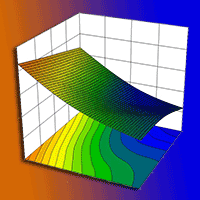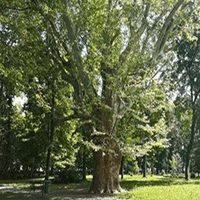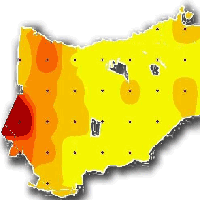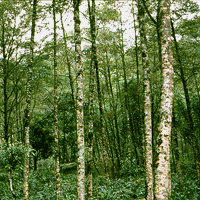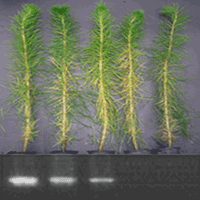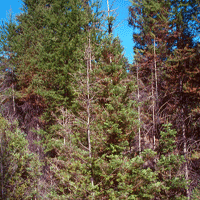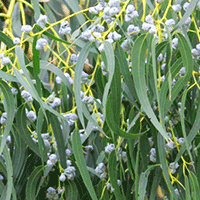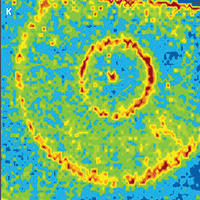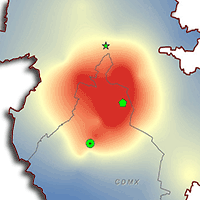The rehabilitation of heavy metal-contaminated lands is a challenging issue worldwide. The application of effective eco-friendly techniques and materials is necessary for amending the contaminated soils, and the in-situ results should be examined. The present study investigated the effect of zero-valent iron-nanoparticles (Fe0-NPs) and cellulosic wastes (CW) on the lead (Pb) and cadmium (Cd) uptake and nutrients’ (N, P, K) concentration of maple seedlings in contaminated soil. First, one-year-old seedlings were planted in pots containing unpolluted soil (volume = 3 Kg), and then the soil was contaminated by adding Pb (0, Pb100, Pb200, and Pb300 mg kg-1) and Cd (0, Cd10, Cd20, and Cd30 mg kg-1) solutions. The CW (0, 10, 20, 30 g/100g soil) and Fe0-NPs (0, 1, 2, 3 mg kg-1) treatments were applied to the soil before and after Pb and Cd addition, respectively. The biomass of seedlings and the concentration of nitrogen, potassium, and phosphorus in leaves were measured. Leaves, stems, and roots were digested to measure the Pb and Cd concentrations. Results showed that CW and Fe0-NPs improved N, P, and K concentrations in leaves at all levels of contamination. The lowest concentration of Pb and Cd in all organs and treatments was observed in the highest level of Fe0-NPs. The cellulosic waste and Fe0-NPs (the highest level only) significantly increased the soil pH at all levels of contamination. Our findings suggested that the use of Fe0-NPs (3 mg kg-1) and CW (30g/100g soil) could be appropriate for reducing the bioavailability of Pb and Cd in contaminated soil and improving the growth of maple seedlings.
Keywords
, , ,
Citation
Tafazoli M, Hojjati SM, Biparva P, Kooch Y, Lamersdorf N (2021). Using nano-scale Fe0 particles and organic waste to improve the nutritional status of tree seedlings growing in heavy metal-contaminated soil. iForest 14: 447-455. - doi: 10.3832/ifor3821-014
Academic Editor
Daniela Baldantoni
Paper history
Received: Mar 22, 2021
Accepted: Aug 05, 2021
First online: Sep 28, 2021
Publication Date: Oct 31, 2021
Publication Time: 1.80 months
© SISEF - The Italian Society of Silviculture and Forest Ecology 2021
Open Access
This article is distributed under the terms of the Creative Commons Attribution-Non Commercial 4.0 International (https://creativecommons.org/licenses/by-nc/4.0/), which permits unrestricted use, distribution, and reproduction in any medium, provided you give appropriate credit to the original author(s) and the source, provide a link to the Creative Commons license, and indicate if changes were made.

Breakdown by View Type
(Waiting for server response...)
Article Usage
Total Article Views: 31198
(from publication date up to now)
Breakdown by View Type
HTML Page Views: 26278
Abstract Page Views: 2656
PDF Downloads: 1771
Citation/Reference Downloads: 5
XML Downloads: 488
Web Metrics
Days since publication: 1524
Overall contacts: 31198
Avg. contacts per week: 143.30
Article Citations
Article citations are based on data periodically collected from the Clarivate Web of Science web site
(last update: Mar 2025)
Total number of cites (since 2021): 3
Average cites per year: 0.60
Publication Metrics
by Dimensions ©
Articles citing this article
List of the papers citing this article based on CrossRef Cited-by.
(1)
Abbasi H, Pourmajidian MR, Hodjati SM, Fallah A, Nath S (2017)Effect of soil-applied lead on mineral contents and biomass in
Acer cappadocicum,
Fraxinus excelsior and
Platycladus orientalis seedlings. iForest - Biogeosciences and Forestry 10: 722-728.
CrossRef |
Gscholar
(2)
Amirahmadi E, Mohammad Hojjati S, Kammann C, Ghorbani M, Biparva P (2020)The potential effectiveness of biochar application to reduce soil Cd bioavailability and encourage oak seedling growth. Applied Sciences 10 (10): 3410.
CrossRef |
Gscholar
(3)
Antonkiewicz J, Pelka R, Bik-Malodzinska M, Zukowska G, Glen-Karolczyk K (2018)The effect of cellulose production waste and municipal sewage sludge on biomass and heavy metal uptake by a plant mixture. Environmental Science and Pollution Research 25 (31): 1101-31112.
CrossRef |
Gscholar
(4)
Bastida F, Jindo K, Moreno JL, Hernández T, García C (2012)Effects of organic amendments on soil carbon fractions, enzyme activity and humus-enzyme complexes under semi-arid conditions. European Journal of Soil Biology 53: 94-102.
CrossRef |
Gscholar
(5)
Borghi M, Tognetti R, Monteforti G, Sebastiani L (2007)Responses of
Populus ×euramericana (
P. deltoids × P. nigra) clone Adda to increasing copper concentrations. Environmental and Experimental Botany 61: 66-73.
CrossRef |
Gscholar
(6)
Boutchuen A, Zimmerman D, Aich N, Masud AM, Arabshahi A, Palchoudhury S (2019)Increased plant growth with hematite nanoparticle fertilizer drop and determining nanoparticle uptake in plants using multimodal approach. Journal of Nanomaterials 2019: 1-11.
CrossRef |
Gscholar
(7)
Cao X, Ma LQ (2004)Effects of compost and phosphate on plant arsenic accumulation from soils near pressure-treated wood. Environmental Pollution 132 (3): 435-442.
CrossRef |
Gscholar
(8)
Cao X, Ma LQ, Shiralipour A (2003)Effects of compost and phosphate amendments on arsenic mobility in soils and arsenic uptake by the hyperaccumulator,
Pteris vittata L. Environmental Pollution 126 (2): 157-167.
CrossRef |
Gscholar
(9)
Chattha MU, Hassan MU, Barbanti L, Chattha MB, Khan I, Usman M, Ali A, Nawaz M (2019)Composted sugarcane by-product press mud cake supports wheat growth and improves soil properties. International Journal of Plant Production 13 (3): 241-249.
CrossRef |
Gscholar
(10)
Coakley S, Cahill G, Enright AM, Rourke B, Petti C (2019)Cadmium hyperaccumulation and translocation in
Impatiens glandulifera: from foe to friend? Sustainability 11 (18): 5018.
CrossRef |
Gscholar
(11)
Cocozza C, Perone A, Giordano C, Salvatici MC, Pignattelli S, Raio A, Schaub M, Sever K, Innes JL, Tognetti R, Cherubini P (2019)Silver nanoparticles enter the tree stem faster through leaves than through roots. Tree Physiology 39 (7): 1251-1261.
CrossRef |
Gscholar
(12)
Dai Y, Sun Q, Wang W, Lu L, Liu M, Li J, Yang S, Sun Y, Zhang K, Xu J, Zheng W (2018)Utilizations of agricultural waste as adsorbent for the removal of contaminants: a review. Chemosphere 211: 235-253.
CrossRef |
Gscholar
(13)
Danila V, Vasarevicius S, Valskys V (2018)Batch removal of Cd (II), Cu (II), Ni (II), and Pb (II) ions using stabilized zero-valent iron nanoparticles. Energy Procedia 147: 214-219.
CrossRef |
Gscholar
(14)
Das H, Singh SK (2004)Useful byproducts from cellulosic wastes of agriculture and food industry a critical appraisal. Critical Reviews in Food Science and Nutrition 44 (2): 77-89.
CrossRef |
Gscholar
(15)
Fajardo C, Costa G, Nande M, Martín C, Martín M, Sánchez-Fortún S (2019)Heavy metals immobilization capability of two iron-based nanoparticles (nZVI and Fe
3O
4): Soil and freshwater bioassays to assess ecotoxicological impact. Science of the Total Environment 656: 421-432.
CrossRef |
Gscholar
(16)
Gil-Díaz M, Pérez-Sanz A, Angeles Vicente M, Carmen Lobo M (2014)Immobilisation of Pb and Zn in soils using stabilised zero-valent iron nanoparticles: effects on soil properties. CLEAN - Soil, Air, Water 42 (12): 1776-1784.
CrossRef |
Gscholar
(17)
Gopal R, Rizvi AH (2008)Excess lead alters growth, metabolism and translocation of certain nutrients in radish. Chemosphere 70 (9): 1539-1544.
CrossRef |
Gscholar
(18)
Gray CW, Dunham SJ, Dennis PG, Zhao FJ, McGrath SP (2006)Field evaluation of
in situ remediation of a heavy metal contaminated soil using lime and red-mud. Environmental Pollution 142: 530-539.
CrossRef |
Gscholar
(19)
Jackson ML (1973)Soil chemical analysis. Prentice Hall of India Ltd, New Delhi, India, pp. 498.
Gscholar
(20)
Jentschke G, Fritz E, Godbold DL (1991)Distribution of lead in mycorrhizal and non-mycorrhizal Norway spruce seedlings. Plant Physiology 81: 417-422.
CrossRef |
Gscholar
(21)
Jing Y, Cui H, Li T, Zhao Z (2014)Heavy metal accumulation characteristics of Nepalese alder (
Alnus nepalensis) growing in a lead-zinc spoil heap, Yunnan, south-western China. iForest - Biogeosciences and Forestry 7: 204-208.
CrossRef |
Gscholar
(22)
Kabata-Pendias A (2001)Trace elements in soil and plants. CRC Press, Boca Raton, FL, USA, pp. 331.
Gscholar
(23)
Kaihura FBS, Kullaya IK, Kilasara M, Aune JB, Singh BR, Lal R (1999)Soil quality effects of accelerated erosion and management systems in three eco-regions of Tanzania. Soil and Tillage Research 53 (1): 59-70.
CrossRef |
Gscholar
(24)
Kim JH, Lee Y, Kim EJ, Gu S, Sohn EJ, Seo YS, An HJ, Chang YS (2014)Exposure of iron nanoparticles to
Arabidopsis thaliana enhances roots elongation by triggering cell wall loosening. Environmental Science and Technology 48: 3477-3485.
CrossRef |
Gscholar
(25)
Kominko H, Gorazda K, Wzorek Z (2017)The possibility of organo-mineral fertilizer production from sewage sludge. Waste and Biomass Valorization 8 (5): 1781-1791.
CrossRef |
Gscholar
(26)
Krupa Z, Siedlecka A, Skórzynska-Polit E, Maksymiec W (2002)Heavy metal interactions with plant nutrients. In “Physiology and Biochemistry of Metal Toxicity and Tolerance in Plants”. Springer, Dordrecht, Netherlands, pp. 287-301.
CrossRef |
Gscholar
(27)
Kumpiene J (2005)Assessment of trace element stabilization in soil. PhD thesis, Luleå Tekniska Universitet. Luleå, Sweden, pp. 132.
Online |
Gscholar
(28)
Kumpiene J, Lagerkvist A, Maurice C (2007)Stabilization of Pb-and Cu-contaminated soil using coal fly ash and peat. Environmental Pollution 145: 365-373.
CrossRef |
Gscholar
(29)
Lamhamdi M, El Galiou O, Bakrim A, Nóvoa-Muñoz JC, Arias-Estévez M, Aarab A, Lafont R (2013)Effect of lead stress on mineral content and growth of wheat (
Triticum aestivum) and spinach (
Spinacia oleracea) seedlings. Saudi Journal of Biological Sciences 20: 29-36.
CrossRef |
Gscholar
(30)
Liu D, Jiang W, Wang W, Zhao F, Lu C (1994)Effects of lead on roots growth, cell division, and nucleolus of
Allium cepa. Environmental Pollution 86: 1-4.
CrossRef |
Gscholar
(31)
Liu H, Zhang J, Christie P, Zhang F (2008)Influence of iron plaque on uptake and accumulation of Cd by rice (
Oryza sativa L.) seedlings grown in soil. Science of the Total Environment 394: 361-368.
CrossRef |
Gscholar
(32)
Liu J, He F, Gunn TM, Zhao D, Roberts CB (2009a)Precise seed-mediated growth and size-controlled synthesis of palladium nanoparticles using a green chemistry approach. Langmuir 25: 7116-7128.
CrossRef |
Gscholar
(33)
Liu WX, Liu JW, Wu MZ, Li Y, Zhao Y, Li SR (2009b)Accumulation and translocation of toxic heavy metals in winter wheat (
Triticum aestivum L.) growing in agricultural soil of Zhengzhou, China. Bulletin of Environmental Contamination and Toxicology 82 (3): 343-347.
CrossRef |
Gscholar
(34)
Liu R, Lal R (2013)An empirical study on improving quality of coal mining refuse for re-vegetation using amendments. Journal of Sustainable Development 6: 44-60.
CrossRef |
Gscholar
(35)
Malik DS, Jain CK, Yadav AK (2017)Removal of heavy metals from emerging cellulosic low-cost adsorbents: a review. Applied Water Science 7 (5): 2113-2136.
CrossRef |
Gscholar
(36)
Marzilli M, Di Santo P, Palumbo G, Maiuro L, Paura B, Tognetti R, Cocozza C (2018)Cd and Cu accumulation, translocation and tolerance in
Populus alba clone (Villafranca) in autotrophic
in vitro screening. Environmental Science and Pollution Research 25: 10058-10068.
CrossRef |
Gscholar
(37)
Matheson LJ, Tratnyek PG (1994)Reductive dehalogenation of chlorinated methanes by iron metal. Environmental Science and Technology 28: 2045-2053.
CrossRef |
Gscholar
(38)
Mehmood S, Saeed DA, Rizwan M, Khan MN, Aziz O, Bashir S, Ibrahim M, Ditta A, Akmal M, Mumtaz MA, Ahmed W (2018)Impact of different amendments on biochemical responses of sesame (
Sesamum indicum L.) plants grown in lead-cadmium contaminated soil. Plant Physiology Biochemistry 132: 345-355.
CrossRef |
Gscholar
(39)
Mohammadi H, Amani-Ghadim AR, Matin AA, Ghorbanpour M (2020)Fe
0 nanoparticles improve physiological and antioxidative attributes of sunflower (
Helianthus annuus) plants grown in soil spiked with hexavalent chromium. 3 Biotech 10 (1): 121.
CrossRef |
Gscholar
(40)
Nweke IA (2017)Effect of compost and earthworm production on soil properties, growth and dry matter yield of maize in crude oil degraded soil. Journal of Soil Science and Environmental Management 8 (1): 1-10.
CrossRef |
Gscholar
(41)
Paulose B, Datta SP, Rattan RK, Chhonkar PK (2007)Effect of amendments on the extractability, retention and plant uptake of metals on a sewage-irrigated soil. Environmental Pollution 146: 19-24.
CrossRef |
Gscholar
(42)
Quevauviller P, Rauret G, Rubio R, Lopez-Sanchez JF, Ure J, Bacon J, Muntau H (1997)Certified reference materials for the quality control of EDTA- and acetic acid-extractable contents of trace elements in sewage sludge amended soils (CRMs 483 and 484). Fresenius’ journal of analytical chemistry 357: 611-618.
CrossRef |
Gscholar
(43)
Ramzani PMA, Coyne MS, Anjum S, Iqbal M (2017)In situ immobilization of Cd by organic amendments and their effect on antioxidant enzyme defense mechanism in mung bean (
Vigna radiata L) seedlings. Plant Physiology and Biochemistry 118: 561-570.
CrossRef |
Gscholar
(44)
Sampanpanish P, Pongpaladisai P (2011)Effect of organic fertilizer on cadmium uptake by rice grown in contaminated soil. In: Proceedings of the “International Conference on Environmental and Agriculture Engineering - IPCBEE 2011”. IACSIT Press, Singapore 15: 103-109.
Online |
Gscholar
(45)
Savasari M, Emadi M, Bahmanyar MA, Biparva P (2015)Optimization of Cd (II) removal from aqueous solution by ascorbic acid-stabilized zero valent iron nanoparticles using response surface methodology. Industrial and Engineering Chemistry Research 25: 1403-1409.
CrossRef |
Gscholar
(46)
Sengar RS, Gautam M, Sengar RS, Garg SK, Sengar K, Chaudhary R (2009)Lead stress effects on physiobiochemical activities of higher plants. Reviews of Environmental Contamination and Toxicology 196: 1-21.
Gscholar
(47)
Seregin IV, Ivanov VB (2001)Physiological aspects of cadmium and lead toxic effects on higher plants. Russian Journal of Plant Physiology 48: 523-544.
CrossRef |
Gscholar
(48)
Siedlecka A (1995)Some aspects of interactions between heavy metals and plant mineral nutrients. Acta Societatis Botanicorum Poloniae 64: 265-272.
CrossRef |
Gscholar
(49)
Singh RP, Agrawal M (2007)Effects of sewage sludge amendment on heavy metal accumulation and consequent responses of
Beta vulgaris plants. Chemosphere 67 (11): 2229-2240.
CrossRef |
Gscholar
(50)
Tafazoli M, Hojjati SM, Biparva P, Kooch Y, Lamersdorf N (2017)Reduction of soil heavy metal bioavailability by nanoparticles and cellulosic wastes improved the biomass of tree seedlings. Journal of Plant Nutrition and Soil Science 180: 683-693.
CrossRef |
Gscholar
(51)
Tafazoli M, Hojjati SM, Biparva P, Kooch Y, Lamersdorf N (2021)Changes in soil chemistry and element uptake by oak seedlings after application of soil amendment. Scandinavian Journal of Forest Research 36 (1): 32-42.
CrossRef |
Gscholar
(52)
Utermann J, Aydin CT, Bischoff N, Böttcher J, Eickenscheidt N, Gehrmann J, König N, Scheler B, Stange F, Wellbrock N (2019)Heavy metal stocks and concentrations in forest soils. In: “Status and Dynamics of Forests in Germany”. Springer, Cham, Switzerland, pp. 199-229.
Gscholar
(53)
Venegas A, Rigol A, Vidal M (2016)Changes in heavy metal extractability from contaminated soils remediated with organic waste or biochar. Geoderma 279: 132-140.
CrossRef |
Gscholar
(54)
Wang Y, Xu Y, Li D, Tang B, Man S, Jia Y, Xu H (2018)Vermicompost and biochar as bio-conditioners to immobilize heavy metal and improve soil fertility on cadmium contaminated soil under acid rain stress. Science of the Total Environment 621: 1057-1065.
CrossRef |
Gscholar
(55)
Weil RR, Brady NC (2016)The nature and properties of soils (15th edn). Pearson, London, UK, pp. 1063.
Gscholar
(56)
Wong MH (2003)Ecological restoration of mine degraded soils, with emphasis on metal contaminated soils. Chemosphere 50: 775-780.
CrossRef |
Gscholar
(57)
Xia Y, Luo H, Li D, Chen Z, Yang S, Liu Z, Yang T, Gai C (2020)Efficient immobilization of toxic heavy metals in multi-contaminated agricultural soils by amino-functionalized hydrochar: Performance, plant responses and immobilization mechanisms. Environmental Pollution 261: 114217.
CrossRef |
Gscholar
(58)
Xu C, Qi J, Yang W, Chen Y, Yang C, He Y, Wang J, Lin A (2019)Immobilization of heavy metals in vegetable-growing soils using nano zero-valent iron modified attapulgite clay. Science of the Total Environment 686: 476-483.
CrossRef |
Gscholar
(59)
Ye ZH, Wong JWC, Wong MH, Lan CY, Baker AJM (1999)Lime and pig manure as ameliorants for revegetating lead/zinc mine tailings: a greenhouse study. Bioresource Technology 69: 35-43.
CrossRef |
Gscholar
(60)
Yi XU, Liang X, Yingming XU, Qin X, Huang Q, Wang L, Sun Y (2017)Remediation of heavy metal-polluted agricultural soils using clay minerals: a review. Pedosphere 27: 193-204.
CrossRef |
Gscholar
(61)
Yoon H, Kang YG, Chang YS, Kim JH (2019)Effects of zerovalent iron nanoparticles on photosynthesis and biochemical adaptation of soil-grown
Arabidopsis thaliana. Nanomaterials 9 (11): 1543.
CrossRef |
Gscholar
(62)
Zhang RH, Li ZG, Liu XD, Wang BC, Zhou GL, Huang XX, Lin CF, Wang AH, Brooks M (2017)Immobilization and bioavailability of heavy metals in greenhouse soils amended with rice straw-derived biochar. Ecological Engineering 98: 183-188.
CrossRef |
Gscholar
